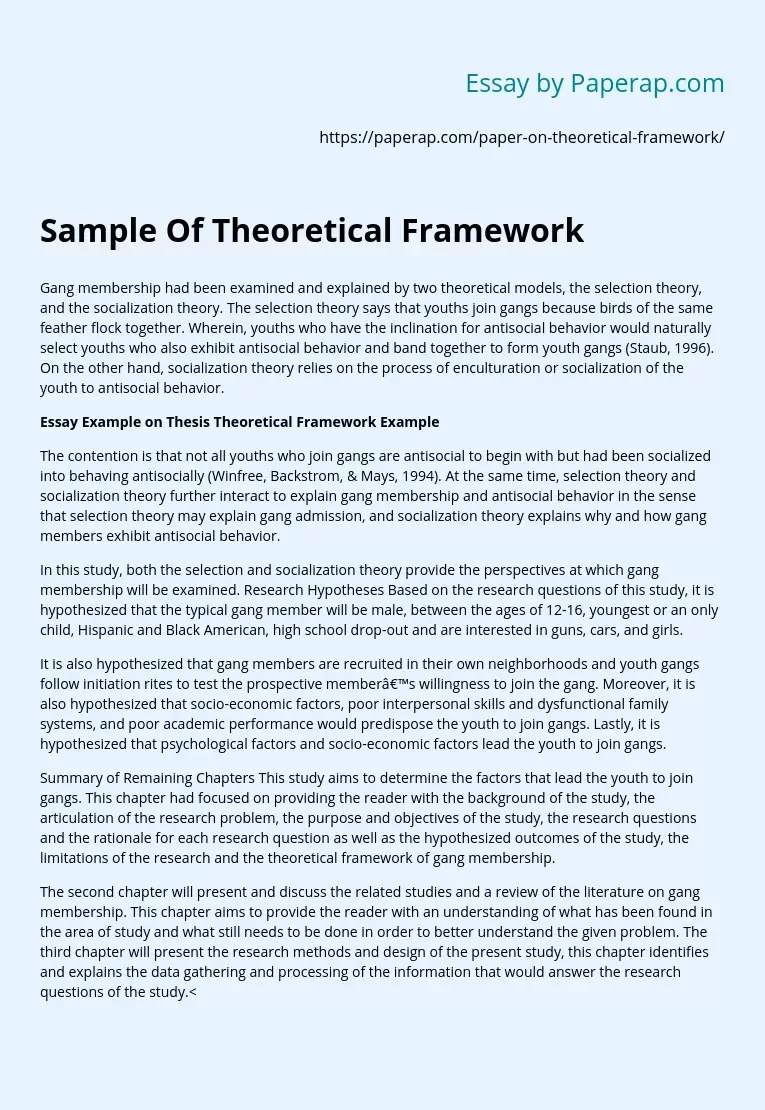Sample Of Theoretical Framework
Gang membership had been examined and explained by two theoretical models, the selection theory, and the socialization theory. The selection theory says that youths join gangs because birds of the same feather flock together. Wherein, youths who have the inclination for antisocial behavior would naturally select youths who also exhibit antisocial behavior and band together to form youth gangs (Staub, 1996). On the other hand, socialization theory relies on the process of enculturation or socialization of the youth to antisocial behavior.
Essay Example on Thesis Theoretical Framework Example
The contention is that not all youths who join gangs are antisocial to begin with but had been socialized into behaving antisocially (Winfree, Backstrom, & Mays, 1994).
At the same time, selection theory and socialization theory further interact to explain gang membership and antisocial behavior in the sense that selection theory may explain gang admission, and socialization theory explains why and how gang members exhibit antisocial behavior.
In this study, both the selection and socialization theory provide the perspectives at which gang membership will be examined.
Research Hypotheses Based on the research questions of this study, it is hypothesized that the typical gang member will be male, between the ages of 12-16, youngest or an only child, Hispanic and Black American, high school drop-out and are interested in guns, cars, and girls.
It is also hypothesized that gang members are recruited in their own neighborhoods and youth gangs follow initiation rites to test the prospective member’s willingness to join the gang. Moreover, it is also hypothesized that socio-economic factors, poor interpersonal skills and dysfunctional family systems, and poor academic performance would predispose the youth to join gangs.
Lastly, it is hypothesized that psychological factors and socio-economic factors lead the youth to join gangs.
Summary of Remaining Chapters This study aims to determine the factors that lead the youth to join gangs. This chapter had focused on providing the reader with the background of the study, the articulation of the research problem, the purpose and objectives of the study, the research questions and the rationale for each research question as well as the hypothesized outcomes of the study, the limitations of the research and the theoretical framework of gang membership.
The second chapter will present and discuss the related studies and a review of the literature on gang membership. This chapter aims to provide the reader with an understanding of what has been found in the area of study and what still needs to be done in order to better understand the given problem. The third chapter will present the research methods and design of the present study, this chapter identifies and explains the data gathering and processing of the information that would answer the research questions of the study.
This chapter would provide the reader the necessary detail that would enable others to replicate the study which is a key aspect of scientific inquiry. The fourth chapter will talk about the results of the data analysis and how it is able to answer the research questions and whether it proves or disproves the research hypotheses. The last chapter presents the discussion, conclusions, and recommendations of the study based on the results of the study. This section provides the reader with information on the implications of the research findings to the local community and to gangs in general.
Sample Of Theoretical Framework. (2019, Nov 27). Retrieved from https://paperap.com/paper-on-theoretical-framework/

